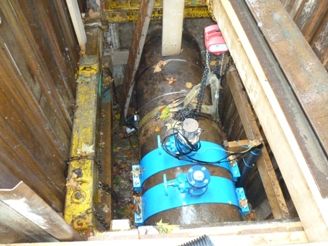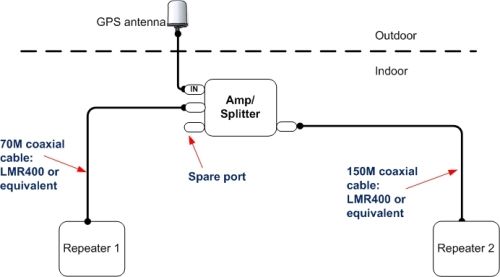GPS repeaters deployed in Crossrail tunnel leak detection system
London, 20 June 2013 – When faced with an unusual and challenging technical requirement, FalTech GPS and Syrinix Ltd partnered to design and install a system to monitor the integrity of large-diameter water main pipes deep under the capital’s landscape.
FalTech’s GPS repeater systems are deployed in a wide variety of locations where GPS satellite signals are required inside a building, and when Syrinix were faced with the prospect of providing GPS timing signals to their monitoring equipment in a tunnel environment FalTech were brought in to help with that situation.
An abandoned tunnel in the Holborn area, known as the Kingsway Tram Tunnel, has been brought back into service by the Crossrail project after a 60 year closure. The tunnel now accommodates many services associated with the drilling process, including large-diameter water mains.
Working collaboratively, FalTech and Syrinix addressed a concern that movement caused by the drilling may affect the water mains in the area while the Crossrail construction work is on-going.

Crossrail is one of the most significant infrastructure projects ever undertaken in the UK. It will provide a high-frequency train service to 37 stations from Maidenhead and Heathrow in the west to Shenfield and Abbey Wood in the east – with 21Km of this route being underground. Massive tunnelling machines are carefully weaving their way between existing underground lines, utility tunnels, water mains, sewers and building foundations at depths of up to 36 metres.
As world leaders in smart pipeline monitoring technology, Syrinix’s TrunkMinder system was developed to continuously monitor water pipelines to provide early identification of emerging and emergent leaks that are often the precursor to a catastrophic failure.
The monitoring process involves fixing a sensor pod to a valve cap on the pipe’s exterior surface. The pod contains geophones, hydrophones and a pressure sensor, and literally listens to the flow of water inside the pipe. Each pipe has its own vocal identity, and if the sound changes from the norm it can indicate a problem.
Each pod receives positioning and timing information from a GPS antenna located above ground, which means that all the monitoring systems along a length of pipe are accurately time-synchronised. The GPS receiving antenna is usually housed in a hardened plastic street bollard, situated up to 25 metres from the pod.
The challenge in the case of the Crossrail project is that the lateral distance from pod to the street bollard is up to 150 metres; not necessarily a problem for a data connection as an Ethernet repeater could be used, but the crucial GPS timing information had to be supplied to the pod as well.
Syrinix sought and found a technology partner in FalTech GPS, a company that specialises in providing GPS signals in areas where it is not normally available. By use of GPS repeater technology, the outdoor signal is transferred to an indoor location and re-radiated where needed.

Neil Pitcher of Syrinix comments; “Although flow monitoring is our core competence, we found ourselves operating in a very unusual and challenging environment, i.e. a tunnel some distance under the streets of London. We were also faced with the problem of providing a GPS timing signal in the vicinity of our monitoring pods and soon realised we had to get some specialist help.
“We contacted FalTech GPS and realised that while this was also a slightly unusual application for a GPS repeater system, we found Phil very accommodating and helpful. With his help, coupled with support from the repeater manufacturer Roger-GPS, we developed a solution through a number of iterations until a working model was finalised.”
Phil Whitting of FalTech GPS continues: “The first issue to overcome was the distance from the street bollard to the pods; one was 80 metres away and the other 150 metres. Not only did we need a splitter to allow a single GPS antenna to provide signal to the two pods below ground, we needed to give the signal a boost to overcome the long cable lengths. We decided to use a combined amplifier/splitter device that boosts the signal by a factor of 16dB and transmits it down the coaxial cables.
“Due to signal losses through attenuation, a very low-loss coaxial cable was specified, with a GPS repeater unit connected to the end of each cable. The signal is re-radiated by the repeaters to provide the essential timing information to the Syrinix monitoring equipment.
“It was a pleasure to work with Neil and the team at Syrinix as they posed a very interesting challenge to our technical skills. The flow-monitoring industry is not a place where I would normally have expected to find a need for indoor GPS signal, yet on the other hand it’s hard to find a device these days that doesn’t contain a GPS receiver chip. In essence, a repeater system means that any GPS-enabled device can receive a signal, no matter how far inside a building it is”
GPS repeater systems are available in kit format, or as a custom-designed system that we will create for your specific needs.
For more information on GPS repeater systems please feel free to get in touch.
There’s an email contact form on this site, or call us to discuss your requirements.
Within the UK dial 01326 336 444 or from outside the UK dial +44 1326 336 444.
Need help to decide which system is right for you?
Or call us on
